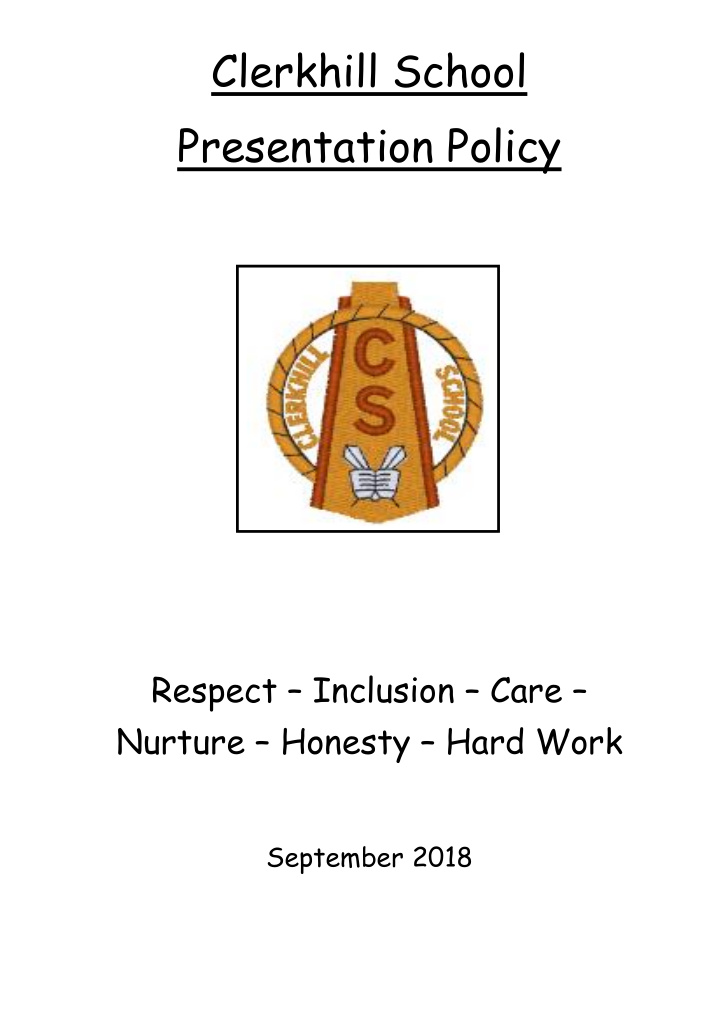



Clerkhill School Presentation Policy Respect – Inclusion – Care – Nurture – Honesty – Hard Work September 2018
Clerkhill School – Presentation Policy September 2018 Purpose The purpose of this policy is to ensure a consistently high standard of presentation across the whole school which all children and staff recognise, understand and follow. Application These expectations are intended to apply to the vast majority of children in our school. Occasionally a decision will need to be made to personalise the presentation expectations for a child who has such specific needs that these expectations could be a barrier to their progress (e.g. a child with physical difficulties). Making it a reality Staff will ensure that pr esentation of work is actively taught as it will not ‘just happen’. It should be a main focus at the start of each academic year and then be referred to periodically throughout the year. Children should be taught where to begin a new piece of work. As a general rule, children will start a new page when there are only a few lines left, otherwise they draw a line with a ruler before starting their new piece of work and miss two lines before writing their title in the centre. Where possible, all staff should ensure that presentation is celebrated through : Displaying work with a high standard of presentation • Celebrating work with a high standard of presentation in whole class situations. • Ensure good presentation is rewarded, in line with whole school behaviour policy (Praise, • House Points, Achievement Awards) Sharing of good work in whole school assemblies. • Monitoring Presentation will be monitored by the Senior Management Team on a regular basis through: Jotter Sampling • Lesson Observations • Pupil Voice Interviews •
Early Level Expectations of presentation at Early Level will change as the year progresses and the children move towards transition onto First Level. It is expected that the majority of children will be writing some words independently when they are showing signs that they are ready to write, should be introduced to cursive letter formation. Dating work Children will independently write the short date e.g. 05.09.18 (using double digits and • decimal point) Writing equipment Pencils, crayons and pens will be freely available for children to enjoy mark making. • When completing colouring jobs, children will be encouraged to use different • colours and to take care with their colouring – staying inside the lines. Learning Intention These may be on display in class or stuck down by the child or an adult. • Staff will encourage: correct letter formation by modelling. • Children to trace the formation of letters on the carpet, in sand etc. prior to • writing with a pencil. Handwriting • Handwriting will be taught in line with the handwriting policy on a regular (at least weekly) basis. The focus of these lessons will be correct letter formation and cursive handwriting. • Children will need to be taught how to write in a cursive style. Our new Letterjoin Scheme will be introduced in line with our handwriting policy. • Staff will emphasise correct letter formation when introducing the whole class to their sounds of the week. All tall letters must touch the top line b d h t k l. • Children should be encouraged to size their letters correctly. • Children must rub out mistakes, not write over the top of their work.
First Level & Second Level Handwriting Cursive writing will be introduced across the whole school in Term 3, 2019. Our • new Letterjoin handwriting scheme will be used in line with our handwriting policy, Handwriting will be taught on a regular basis with a focus on correct letter • formation and cursive handwriting. Handwriting jotters and accompanying worksheets will be used for this as part of a • whole school progression. Maths First Level • Title in the centre e.g. SHM 4 pg. 26 Fractions • One digit in each square • Questions should be numbered and the use of a bracket to separate the question number from the answer e.g. 1a) 3 apples • Rulers must be used to draw lines. Second Level • Textbook page and focus e.g. SHM 4 pg. 26 Fractions (Textbook, Page, Focus) • Children must use a ruler to underline chimney sums • Final answers must also be underlined twice. Literacy • All work dated. • Title: Middle of the page and lesson focus e.g. Question Marks • Learning Intention and Success Criteria written at the top of each new piece of writing. If typed, please use no smaller than 12 font Comic Sans/Sassoon Primary Font 14 to make it easier for pupils to read. Language used should be clear and child friendly. • Big Writing – Take a new page for each piece of writing. For all other written pieces, children in P3 upwards, draw a line under their previous piece of work and start new work below the line. • Begin writing next to the margin or the left-hand side of the page. • Feedback should relate to the Success Criteria.
All Stages Marking & Feedback • Adults will use pink and green pens to indicate success and ‘next steps’ in children’s learning, on all pieces of work. If a question is incorrect it will be marked with a green dot. Use pink to mark on C when corrected. Dating work Date written on left, inside the margin where there is one. • Children will write the short date e.g. 05.09.18 (using double digits and decimal point) • Jotters -Front Cover First Name and Surname _____James Smith_____ _______Maths________ Type of Jotter _________P6T_________ Class No Graffiti or Doodles on front cover or inside the jotter! INSPIRE BELIEVE WORK HARD ACHIEVE
Recommend
More recommend